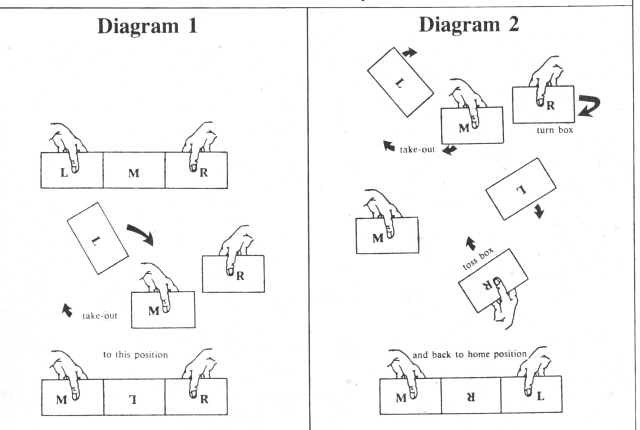 |
Page 31 Winter 1986 - 87
|
TIPS & TRICKS Fancy
cigar box moves (reprinted
with permission from' 'The Juggler's Manual of Cigar
Box Manipulation & Balance," by Reginald W. Bacon)
A
tumble is a
take-out with extra added attraction. The tumbles are so called
because the outside boxes tumble endover-end in an arc.
Diagram
1 illustrates the basic tumble. Release the left box on the upswing
and direct it up and to the center above the middle box. While the
left box is taking a 180 degree half-tumble, grab the middle box
with the free hand and bring it to the outside. Pin the bumbling
box as it comes around.
The
tumble is an audience favorite best put forth by alternate right and
left side tumbles. Also try a 360 degree tumble, or a tumble with an
end-turn combination. a
180 or 360 degree clockwise toss. *
Line
up and juggle weirdly Here's
an easy and fun group juggling pattern that can work with three or
more people. It's a variation of partners juggling, where one
person's right hand and another's left hand work together in a three
object cascade. But in this version, your right hand is working with
one person while your left hand works with another!
A
line of any number of people stand side by side, two balls in the
right hand and one in the left. (It would work equally well with
clubs for more skilled jugglers.) Up, down, and all toss right hand
throws simultaneously to the left hand of the person on their left.
You'll quickly notice that the person to your right tossed ,a ball
to your left hand as well! You
have to respond to that toss with a left hand return, but watch out,
the person on your left has just tossed one to your right! Everyone
juggles simultaneously right, left, right, left, etc.
To
even things out, the person on the right hand end of the line holds
only two balls in the right hand and juggles using only that hand.
The person on the left hand end holds only one ball in the left hand
and only uses that hand.
The visual effect is one of balls flying first right, then left. From inside the pattern, you must keep your eyes up to watch for incoming objects. It's confusing at first, but a lot of fun. With enough people, you can bend the line around to form a circle and try an endless cascade!
Jongleurs
chart progress by Tom Sparough The
Jongleur Jugglers of Gainesville, Fla., devised a way to strengthen
their routine and minimize drops in preparation for the IJA Teams
Championship in San Jose.
"It
was just a mess, and we figured we had to do something,"
Creveling said.
"It
was a very useful tool to look objectively at how well we were
doing," Wetherell said.
..
After 50 or 100 times you can see if there is any particular part
really throwing you," Creveling added.
The
team used the chart 35 times over a four month period before the
convention, Stillwell stated. "Right in the beginning we had to
be realistic and drop a couple of tricks out."
He
said the idea was to make practice time more productive. The chart not
only helped evaluate progress, it motivated them to get through the
routine completely and with a specific goal.
The
trio agrees that the chart added a helpful structure to the practice
sessions. Wetherell said, "We tended to think we were a lot
better than we were. We were very surprised to find out how much we
dropped.'
The
chart adds an objective view missing during their regular public
performances. Because of the comical manner they handle drops, the
Jongleurs amused the audience even with technically sloppy
performances. If the audience enjoyed the show, the group was also
happy , Wetherell said. "We don't remember that we dropped. We
remember we had a good time. "
But
the IJA competition demanded a higher level of technical
performance, and the chart system helped them achieve that.
Stillwell found that he was also a little less nervous for the
competition this year. "I was less nervous because I was being
more realistic, as where the year before I wanted to do a perfect
show." He had prepared himself this year for the fact that they
were most likely going to have a couple of drops, and that took some
of the pressure off.
One
problem they encountered was trouble remembering exactly where their
drops occurred unless someone watched them during practice. Friends
really helped out, but after awhile "all our friends got real
tired of seeing that same routine, " Creveling said.
But
overall, they recommend the system to anyone seriously practicing a
set routine for any purpose. "In past year we would just
practice what we felt like practicing, " he said. The chart gave them the insight to spend the time on the portions of the routine that needed the most work. Performance
tips by Joey Jordan ·
Fingernail polish remover is an excellent solvent for cleaning
props. They should be cleaned frequently to remove the buildup of
sweat and dirt that makes them sticky. · For those who wear stage
makeup,
·
As you would never end a performance with a missed trick or mistake,
nor should you complete a practice session on a negative note. If
there is a move that you just can't accomplish at the moment, don't
quit and finish frustrated. Drop down a level of difficulty and
complete an easier move successfully before putting away your props.
* |
 |